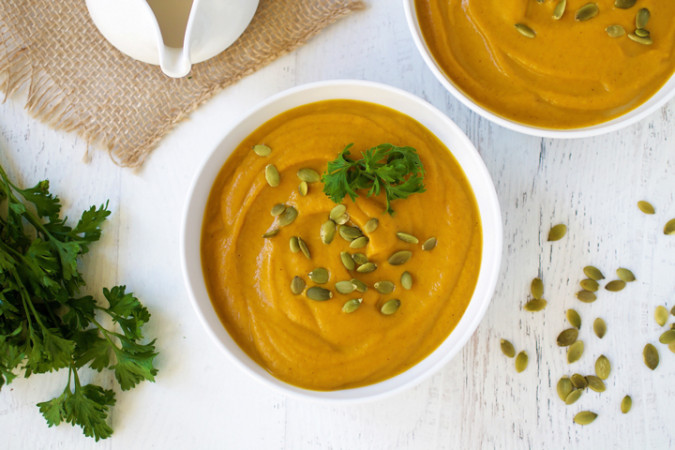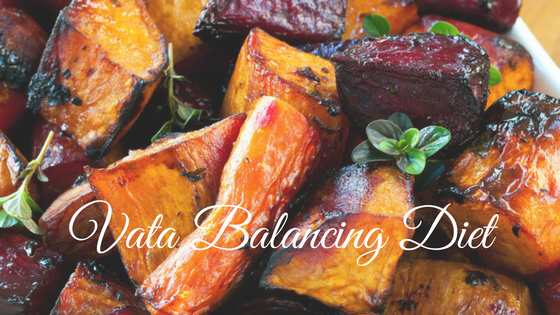Vata Balancing Diet

✫ Vata Balancing Diet ✫
THE BEST FOODS FOR:
.
Vata Season – Autumn + Winter
Vishama Agni = Irregular Digestive Fire
.
.
EMPHASIZE:
Sweet, Salty and Sour taste
.
.
REDUCE:
Bitter, Pungent and Astringent taste
.
.
{To read more about the 6 Tastes click here}
.
.
Vata qualities are: dry, light, cold, subtle, mobile and rough
Vata balancing foods are: moist, heavy, warm, grounding and oily
.
.
The vata balancing diet is for the fall and winter season, for anyone who is experiencing more vata in their body/mind, or has a variable type digestion.
A vata diet is warm, sweet, grounding, hydrating, nourishing and oily. Cooking your food, rather than eating it raw, adds the warm element and makes it easier to digest, which prevents the gas and bloating. Using a lot of oils when cooking and adding healthy fats to meals balances the light, rough and dry qualities of the fall and winter or excess vata in the body. If you choose to eat a salad, it’s best to massage the greens with high quality oil and allow it to marinate for 30 minutes or longer, such as making it during breakfast so it’s ready by lunchtime.
Soups, stews, and one-pot meals are heavenly for vata. Think of all the yummy fall vegetable soups or winter stews.
Emphasize more cooked foods – sauté or steam your veggies, enjoy hot herbal tea, and have more liquid type meals.
Avoid too many raw salads or vegetables, too many green smoothies, snacks, dry or packaged food, dried fruits, iced or carbonated drinks, caffeine, white sugar and processed food.
Meals should be at the same standard time everyday. Vata people might want to have three or even four meals a day, and avoid changing the mealtime for any reason.
Always sit down and enjoy your meal. Be ready to take in your nourishment. Close off all distraction, and never eat while standing up or on the go.
.
.
.
.

Best Foods for Vata Dosha
FRUIT:
Sweet, sour and heavy. Warm when appropriate. Eat alone or 30 minutes before a meal. Avoid astringent or dried fruits.
Apples (cooked), Apricots, Bananas, Blueberries, Cantaloupe, Cherries, Coconuts (ripe), Cranberries (cooked), Dates, Figs, Grapefruit, Grapes, Guava, Lemons, Limes, Mangoes, Nectarines, Oranges, Papayas, Peaches, Pears (ripe), Persimmons, Pineapples, Plums, Strawberries, Tangerines
VEGETABLES:
Sweet and root veggies are best. Eat them cooked (not raw) and use healthy oils or ghee with spices.
Avocados, Beets, Brussels Sprouts, Carrots, Chilies, Pumpkins, Seaweed, Acorn Squash, Winter Squash, Sweet Potatoes, Garlic
GRAINS:
Warm, heavy and cooked grains are good for vata. Dry cereals, crackers, and granola are unbalancing. Gluten and processed starches are also recommended to be limited or avoided.
Amaranth, Buckwheat (moderation), Millet (moderation), Oats, Quinoa, Rice, Rye (moderation), Wheat
LEGUMES:
Most legumes are astringent and have a drying, gassy effect. It’s best to soak legumes or beans overnight to ease digestion and cook with spices.
Chickpeas, lentils, mung beans, split mung dal, tofu
NUTS AND SEEDS:
Almost all nuts are good for vata, especially nut butters or when soaked and sprouted or roasted.
Almonds, Brazil Nuts, Cashews, Coconuts, Filberts, Flax, Lotus Seed, Macadamias, Peanuts (raw), Pecans, Pinons, Pistachios, Sunflower, Walnuts
OILS AND FATS:
Healthy oils are important for fall & winter, and a high vata dosha. Almost all oils are good.
Sesame, olive oil and ghee are best.
Almond, Avocado, Coconut, Flax, Mustard, Olive, Peanut, Safflower, Sesame, Sunflower
DAIRY:
Dairy is grounding and nourishing for vata. For easier digestion, warm up the milk – such as a hot golden turmeric milk.
Butter, Buttermilk, Cheese, Cottage cheese, Cream, Ghee, Soft cheeses rather than hard.
SPICES AND SEASONING:
Warming spices are great for vata. Just avoid anything too “spicy” or hot, as it can be drying. Such as cayenne.
Anise, Asafetida, Basil, Bay Leaf, Black Pepper, Caraway, Cardamom, Chamomile, Cinnamon, Clove, Coriander, Cumin, Dill, Fennel, Fenugreek, Garlic, Ginger, Horseradish, Marjoram, Mustard, Nutmeg, Oregano, Peppermint, Poppy Seeds, Rosemary, Saffron, SALT, Sage, Spearmint, Tarragon, Thyme, Turmeric
SWEETENERS:
Sweetness helps to soothe and ground high vata. All natural sweeteners are good, except honey, which should be used sparingly due to its heating and scraping effect.
Coconut Sugar, Maple Syrup, Molasses, Raw Sugar, Rice Syrup
DRINKS:
It’s important to drink a lot of water for vata types and vata time of year. Sip water all day! Avoid cold, iced drinks, carbonation, caffeine, and alcohol. Warm herbal teas and warm nut milks are great for vata.
Cardamom, Chamomile, Cinnamon, Cloves, Ginger, Orange Peel, Tulsi Tea
Food lists are adapted from Dr. John Douillard.
For help with any type of digestive issues or vata imbalance, please schedule an Ayurveda Consultation.
[embed_popupally_pro popup_id=”4″]
